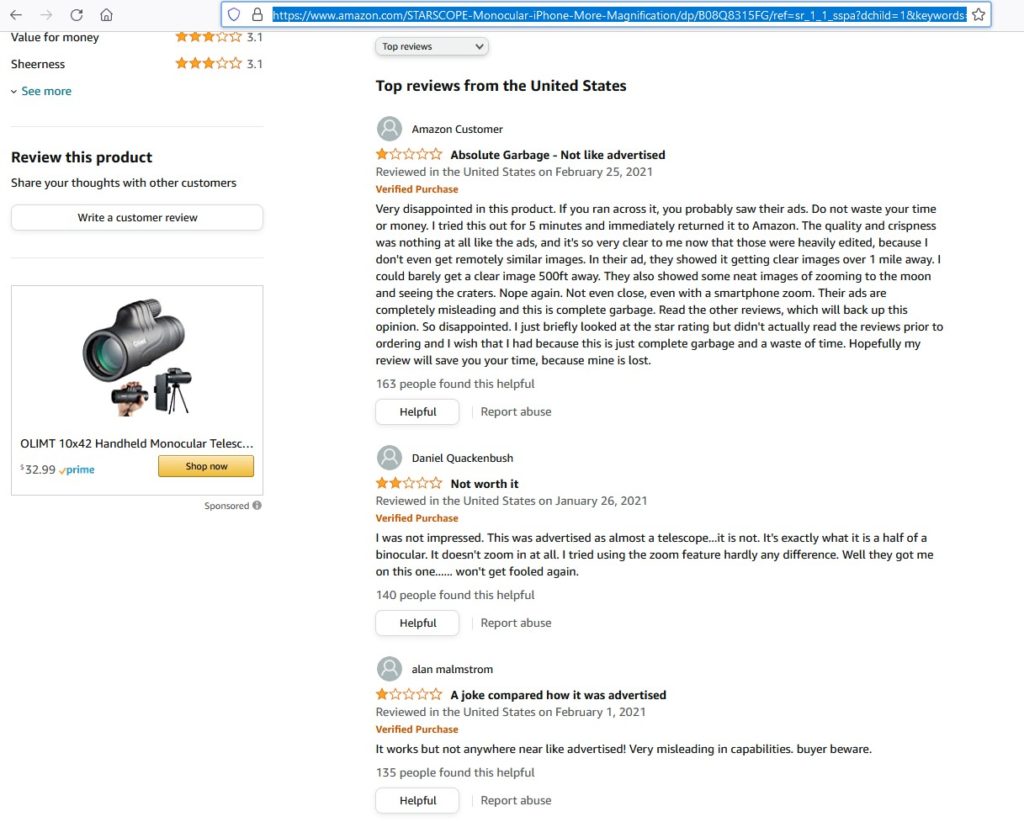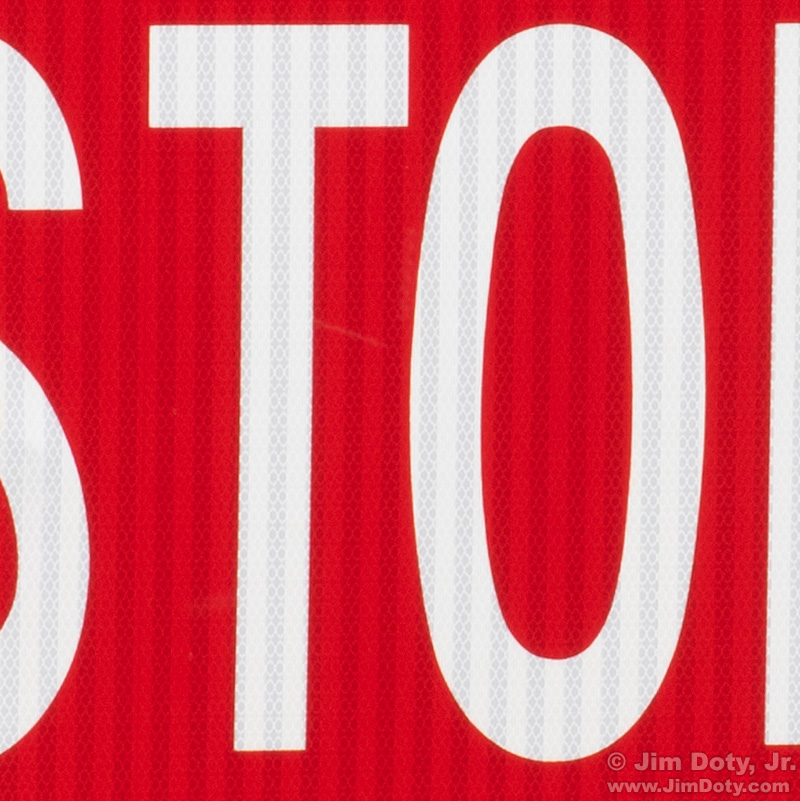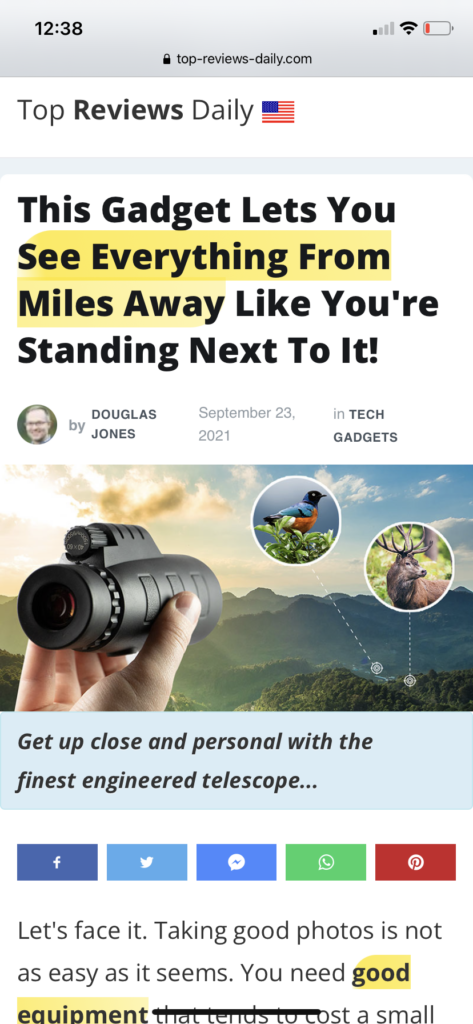
We’ve been down this road before (see the first link at the end). The scam works like this. Pick an inexpensively made product from China, jack up the price, make up ridiculous and false claims about the quality of the product and what it can do, and sell it on dozens of web sites using ads thinly disguised as articles. Go to the internet and grab professional photographs created with high dollar professional camera gear and put the photos in the ads to give the impression the photos were made with the Chinese product. And for good measure, say in the ads that the product was designed by American or German engineers and manufactured in the U.S. or Germany. Create fake customer reviews to go in the ads, and for good measure, create fake reviews sites to endorse the quality of the product.
Now for a look at the Starscope Monocular Telescope. We will look at the ads, the claims, and the professional photos that were grabbed to use in the ads. I also bought one of these monocular telescopes for less than $10 to test it. The current going rate for a Starscope Monocular Telescope at these internet ad sites is around $49 but I have seen prices as high as $79.
Bogus Claims
In the screen capture above, the claim in the ad is you can see “everything from miles away like you are standing next to it.” That is ridiculous. It has about the same magnification as 10X binoculars but with less quality than an average pair of 10X binoculars. Look through a pair of 10X binoculars, close one eye, and what you see is better than if you buy a Starscope monocular telescope. Note the illusion in the image that the Starscope will let you see an elk from miles away just like you are next to it, simply by using the Starscope. That is utter nonsense.
This is a screen capture from the same ad with two more ridiculous claims: the Starscope is “better than $3,000 telescopes” and it will give you the “power of a $4,000 DSLR in your pocket”. Seriously? If you believe that I have a bridge in Brooklyn to sell you. And you can’t “zoom in from miles away”. There is no zoom. (The rubber cup around the eyepiece rotates but it doesn’t change the optics. It just moves the cup.) All you can do to change the image is to focus with the knob on top.
Look familiar? Here’s another ad disguised as a review article. It uses the same “everything from miles away like you’re standing next to it” phrase in the review title, and the same leading image with bird and elk insets, as if we can’t figure out this is coming from the same source. Dozens of sites use some of the same come-ons and photos.
Where Do These Monoculars Come From?
Despite what some of the ads say, these monocular telescopes are mostly from China. There are lots of sources selling inexpensive Chinese goodies. Here is one of them.
Anyone can go in to business. You can get these monocular telescopes for as little $8.15 each if you buy a large enough quantity. If you want a smart phone holder it will cost you $8.92 each when purchased in a large enough quantity. I have no problem with buying and selling these items. My issue is making false, outrageous claims, charging ridiculously high prices, and using images created with professional camera gear and giving the impression they are Starscope images. More about that in the next section.
The Professional Photos in the Ads
Yet another screen capture from the same ad. Although the ad never says any of the photos in the ad were actually made with the Starscope Monocular Telescope, these photos are placed in the ad to give you that impression, complete with an overlay of the monocular telescope over the four photos.
This same set of four photos is used on dozens of web sites. Sometimes the product names and descriptions are different, or the finish of the monocular telescope looks a little different, but it is the same exact set of four photos with the overlay of the Starscope attached to a smart phone.
The ads also appear in multiple languages.

I went looking for the original images used in this set of four photos and found all four of them. All four were taken by professional photographers with professional camera gear. To save time and space, I will use just one as an example. This is the original image of the baseball pitcher. It was created with a Canon EOS 1D Mark II camera body and a 300mm f/2.8 lens. We are talking high dollar professional gear. The lens that was used to create this image costs $6,000. Obviously, this image was not created with the Starscope.
In this ad you are given the impression you can zoom in on this woman on the beach. Of course this woman isn’t even on this particular beach.

The beach image in the ad is a stock photo of a beach in southern France, created with a Canon 5D Mark III DSLR and an expensive ($850) 35mm f/1.4 DG HSM Sigma Art lens.

This is the photo of the woman that was used in the ad. Where did it come from?

It is a stock photo available at Dreamstime. The young woman in the ad was no where near the beach in France. She was photographed at La Digue, Seychelles off the coast of East Africa. This copyrighted image was created by Elena Rudakova, a professional photographer who was born in Moscow and is based in Russia. You can see more of her beautiful images here.
Elena uses high dollar Nikon gear.
Fake Review Sites

You have to wonder up front about a site that has “honest” in its name. This is one of several sites that have “reviews” for the Starscope. They all give it high marks.
And a review site is even more suspicious when it uses the same claims, words, and even the same font as in the ads.
Real Reviews

Real reviews from actual customers are not nearly so flattering.
A Visual Comparison

I bought one of these goodies from Amazon for less than $10 just to test it out. This is just a basic monocular, just like any other monocular. It is half a pair of binoculars. Calling it a telescope is a huge stretch. Technically speaking, a pair of binoculars is like having two side by side miniature telescopes, but with a much lower power/magnification rating than a typical telescope. Most people don’t refer to binoculars and monoculars as telescopes. It is part of the over the top hyperbole in these ads.

My first test was a visual comparison to a pair of 10×50 Bushnell binoculars (with 10X magnification). I closed one eye when using the binoculars to just to keep things as even as possible. In short, using half the binoculars gave me more magnification than the Starscope, and better image quality. When I looked at a distant brick building, the Bushnell binoculars showed more “definition” and details in the brick wall. I could see the bricks with the Starscope but they were a little less sharp. The Bushnell binoculars gave me good quality and the Starscope not as good a quality. As a monocular the Starscope is not bad, but it is below the quality of an average pair of medium grade Bushnell binoculars, and with less magnification than the binoculars.
I must say I was surprised. For $10 the Starscope is an ok monocular. If you want an inexpensive monocular with “fair” but not quite “good” image quality, it will do the job. It would also make a great, low cost toy for an older child.
Despite some of the ads saying the Starscope will “zoom”, it will not. It has a fixed magnification somewhere less than 10X.
A Photographic Comparison Test
To get the maximum image quality, I put the zoom monocular “telescope” on a tripod and used the smart phone holder that came with the zoom monocular. It is a plastic, fiddly thing and does not at all feel secure. At does not keep the iPhone properly aligned with the monocular. I kept one hand on the iPhone at all times to hold it in alignment with the monocular. If I didn’t do that, the iPhone would sag in the flimsy holder and go out of alignment, as in this photo. So with my left hand holding the iPhone against the monocular, I used my right hand to focus the knob on top of the monocular. Without a tripod it would be really difficult to keep the monocular aimed at the subject, the iPhone in place and aligned against the monocular, and focus on top of all of that.

My test target was a stop sign about 90 feet away. I photographed the sign with the Starscope Monocular Telescope with attached iPhone, and with a Canon 7D Mark II camera with a Canon 100-400mm Mark II lens. The ads says the Starscope is better than a $3,000 telescope and it is like having a $4,000 DSLR in your pocket. My camera and lens cost way less than that.

I created 14 images with the Starscope in an attempt to get a good one, and this is the best image. The flimsy smart phone holder meant I had a lot of blurry images. I took off the holder and held the phone against the Starscope which was still mounted on the tripod. The images were about the same. Hand holding the Starscope and iPhone (without using a tripod) is an awful way to try and take pictures. I tried it without much success. I suspect most people who buy the Starscope do not plan on using a tripod, meaning they are doomed to images that are difficult to create, many of them blurry.
The instructions (in poor English) said there would be vignetting. As you can see, there is.

This is the center of the Starscope image at 100% actual pixels magnification. It is a somewhat blurry image due to the less than average optical quality. Keep in mind this is the best of the tripod mounted images, and I did everything possible to get a sharp image. This is as good as a Starscope image gets.

This is one of my DSLR images. It was easy work to get sharp images with a tripod mounted DSLR and a quality lens. I only took three photos and they all look sharp. And with much less hassle than the Starscope.
I did not “sharpen” any of these comparison images. This is exactly how they came out of my iPhone and my DSLR.

This is the center of the Canon 7D2 image at 100% actual pixels magnification. The Canon 7D2 and 100-400mm lens give you a lot more magnification, and a much sharper, clearer image.
There is no way the Starscope is better than a $3,000 telescope with a $4,000 DSLR.

One more comparison image. Here are both 100% actual pixels images, next to each other.
Addendum: What if you try the digital zoom feature of your smartphone?
The instruction manual that comes with the Starscope suggests using the digital zoom feature on your phone so the image doesn’t vignette.
You get more magnification but with the same poor image quality. Note the purple and yellow fringing around the top of the sign and the letters.
Here is the center of the digitally zoomed image at 100% actual pixels magnification. Note again the purple and yellow color fringing at the top of the letters. You get a little more magnification than you do with the Canon 7D2 and 100-400mm lens, but no where near the image quality. You can get the same essential result by taking the original, non-digitally zoomed Starscope image and enlarging it to 400% magnification. I tried it. The original image enlarged to 400% is actually a smidge better than the digitally zoomed image. Either way, both Starscope images are poor in quality, with or without using the digital zoom on your phone.

Once again, here is the Canon image at 100% actual pixels magnification.
Buyer Beware
In the past, the online sites running these scams were based in China or somewhere else far beyond the reach of the U.S. legal system. People who bought from these sites were often seriously overcharged and stuck with high shipping prices. Sometimes they never received the item they ordered. People could not get refunds. They found out the U.S. address was just a mailbox, and the company was actually based half way around the world. If you are going to buy one of these goodies, buy it from a known site operating in the U.S. I found my cheap Starscope at Amazon, and it was shipped by Amazon, not some unknown shipper half way around the world.
Update: Since writing this article I have heard from people who bought the Starscope and later found this review. They were seriously disappointed in the Starscope and they found the Starscope as difficult to use as a lens as I did.
The Bottom Line
This is a fun, cheap workable monocular if you don’t mind something that is a bit below average quality.
This is a truly lousy lens for a smart phone. There are better smart phone lenses out there, and some of them give you more magnification. Check the second and third links below. There is no smart phone telephoto lens out there that will turn your phone into the equivalent of a DSLR and a quality 300, 400, or 500mm telephoto lens, much less a telescope.
You can get a lot of optical magnification with a phone accessory, but it will cost you. At one of my photo workshops a photographer showed up with an expensive (hundreds of dollars) spotting scope and a solid quality iPhone adapter. He could take some decent images with that rig. Not razor sharp, but definitely fun. But the spotting scope was big and he had to use a tripod. That is a far cry from a 6 1/4 inch monocular on your smart phone.
Originally posted October 11, 2021. Updated December 19, 2021. Slightly modified March 31, 2025.
Links
The Chinese Lens Rip Off Series – Overpriced Camera Phone Lenses
The best lenses for iPhone photography
More Warning Links
Debunking the Outrageous Claims Made by the Starscope Monocular Lens












